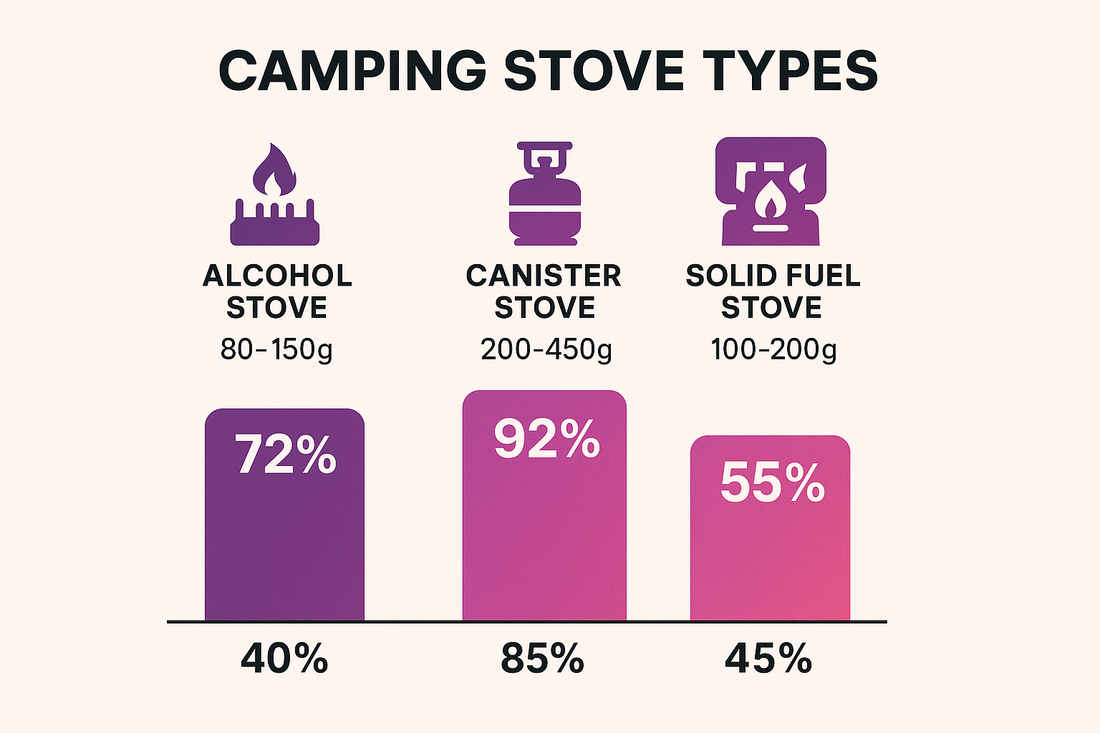
Three Major Stove Types: A Scientific Evaluation
Share
Three Major Stove Types: A Scientific Evaluation
The three major types of camping stoves—alcohol stoves, canister stoves, and solid fuel stoves—differ significantly in performance, catering to lightweight or efficient cooking needs in different scenarios. The following table and analysis are compiled based on 2025 outdoor gear review data and mainstream stove comparison articles.
Core Data Comparison of the Three Major Stove Types
| Stove Type | Avg. Weight | Thermal Efficiency (Boiling 500mL) | Ignition Ease | Flame Control | Temp. Range | Wind Resistance | Security Check / Portability |
|---|---|---|---|---|---|---|---|
| Alcohol Stove | 80–150g | 40–72% (Honeycomb conduction models) | Medium | None | >5°C | Weak | Check-in Allowed |
| Canister Stove | 200–450g | 85–92% (4400–11000W power) | Easy | Precise | -20°C to 40°C (Preheat tube req.) | Excellent | Cannot Fly in Checked Luggage |
| Solid Fuel Stove | 100–200g | 45–55% | Easy | Limited | All Temperatures | Medium | Check-in Allowed |
Performance Evaluation Breakdown
-
Alcohol Stove
- Uses liquid or solid alcohol fuel. Features an extremely simple structure and high portability, making it the top choice for ultralight backpackers.
- Thermal efficiency is significantly affected by wind. However, newer models with honeycomb conduction designs can achieve up to 72% efficiency, boiling 500mL of water in approximately 6 minutes.
- Drawbacks include the inability to regulate flame, and combustion performance drops noticeably in low temperatures.
-
Canister Stove
- The mainstream choice in today's camping market. Combustion efficiency reaches around 90%, with common power outputs ranging from 2600W to 11000W.
- Can operate stably in conditions as low as -20°C (requires a preheat tube). Ideal for four-season camping or comfortable base camping, offering quick ignition and stable flame.
- The main limitation is that fuel canisters (containing flammable material) cannot be carried on airplanes.
-
Solid Fuel Stove
- Uses hexamine/esbit or solid alcohol fuel tablets. Features simple ignition and zero risk of liquid spillage.
- Burn time is long but the flame is gentle, suitable for slow simmering or emergency heating.
- While thermal efficiency is relatively low (~50%), it is lightweight and faces no restrictions for international air travel security checks. Suitable for all temperature scenarios, it is a safe backup option for travelers.
Typical Usage Scenario Recommendations
| Usage Scenario | Recommended Stove | Rationale |
|---|---|---|
| Four-season long-distance camping | Canister Stove + Preheat Tube | High efficiency, cold resistance, adjustable flame |
| High-altitude trekking / Cold regions | Preheat-type Canister Stove | Stable combustion with high-pressure canisters |
| Air Travel & Trekking | Solid Fuel Stove | Passes security checks, solid fuel |
| Summer Ultralight / Fastpacking | Alcohol Stove | Ultralight, fuel easily sourced locally |
| Rainy/Snowy or Windy Areas | Remote Canister Stove | Excellent wind resistance, stable, compatible with larger pots |
Conclusion: The Rational Choice
- 5-Star (All-Season Versatility): Canister Stove + Preheating System (Efficiency up to 90%, superior low-temperature performance)
- 3-Star (Air Travel & Trekking): Solid Fuel Stove (Fuel is carry-on compliant, low explosion risk)
- 2-Star (Ultralight Speed Focus): Alcohol Stove (Thermal efficiency limited, recommended for summer/lowland use only)
The differences in weight, thermal efficiency, flame control, safety, and portability among these three stove types make informed selection and combination a key aspect of scientifically configuring outdoor gear.
